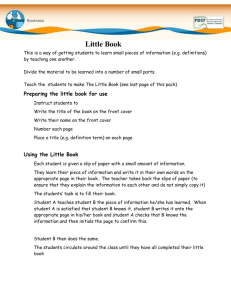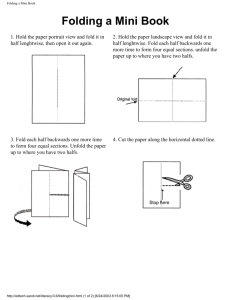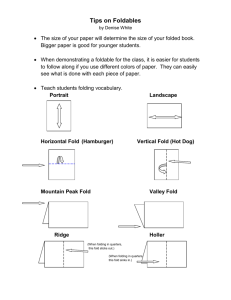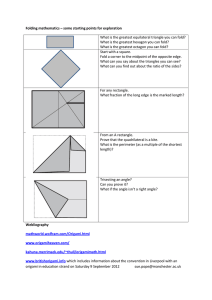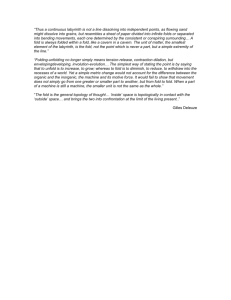.
advertisement
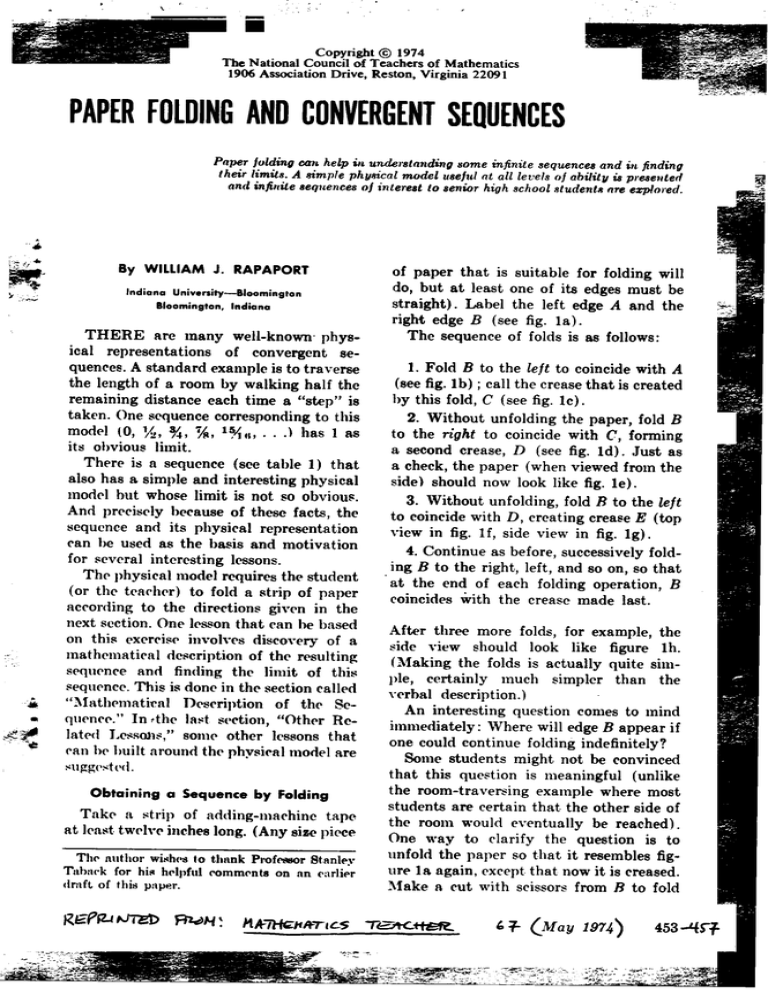
.
.
..
"
-,
Copyright @ 1974
The National Council of Teachers of Mathematics
1906 Association Drive, Reston, Virginia 22091
PAPER FOLDINGAND CONVERGENTSEQUENCES
Pllper Jvlding can help in u~rstllnding
some infinite sequences and in finding
t heir limits. A simple physical model useJul lit alllet.'els oj ability is presellterf
and infiltite sequences oj interest to senior high schoolstudent..s lire explore({.
..
Ii?::
~
.I
By WILLIAMJ. RAPAPORT
"'
I
~
I
..
.
'-'-""
~
do, .but at least one of Its edges must be
stralg
t).
e tee
t e ge
an
e
IndIana
Unlverslty-Blaamlngton
Bloomington,
Indiana
""
h
THERE are many well-known physical representations of convergent sequences.A standard example is to traverse
the length of a room by walking half the
remaining distance each time a "step" is
taken. One sequencecorresponding to this
mod('l (0, ~~, ~~, ~, l~~fl' . . .) has 1 as
its ohvious limit.
Thpre is a sequence (see table 1) that
also has a simple and interesting physical
model but ,,'hose limit is not so obvious.
Ano preeisely beeauseof these facts, the
sequenceand its physical representation
can he used as the hasis and motivation
for several interesting lessons.
The physical model requires the student.
(or th(' teacher) to fold a strip of paper
accorning to the directions given in the
next section. One lessonthat can he based
on this ex('rcis(' involves discovery of a
mathematical de~cription of the resultin~
s()quence and tinning the limit of thi~
~equ('nc('.This i~ don(' in th(' ~ection callpd
"Mathematical D('scription of the SeC]IIPnce."In ,th(' la~t s('ction, "Other Relat('(1 I.(,~Ro.11~,"
some other lessons that
can he Imilt around th() physiral modpl are
"U!!~(",t('(I.
Obt
0
0
alnlng
Tak{'
a
It ~trip
Lab I h I f
d
A
d th
right edge B (see fig. la).
The sequenceof folds is as follows:
1. Fold B to the left to coinci~e with A
(seefig. Ib) ; call the creasethat IScreated
by this fold, C (see fig. lc).
2. Without unfolding the paper, fold B
to the right to coincide with C, forming
a second crease, D (see fig. Id). ,Just as
a check, the paper (when viewed from the
side) should now look like fig. Ie).
3. Without unfolding, fold B to the left
to coincide with D, creating creaseE (top
view in fig. If, side view in fig. Ig).
4. Continue as before, successivelyfolding B to the right, left, and so on, so that
at the end of each folding operation, B
coincides with the crease made last.
After three more folds, for example, the
side view should look like figure Ih.
(Making the folds is actually quite simpie, c('rtainly much simpler than the
verbal deseription.)
An interesting question comes to mind
immediately: Where will edgeB appear if
one could continue folding indefinitely?
Some students might not be convinced
that this question is meaningful (unlike
the room-traversing
. example where. most
Sequence by F0 IdIng
O
of adding-machine
of paper that is suitabl~ for folding will
tape
at l{'a~t tw{'lv{' inches long. (Any size piece
students are certaIn that the other side of
the room would eventually
be reached).
One \\'ay to clarify the question is to
.
figTh~ J\\lthorWI"h('"
10thllnk Prof('8l!or
StanlE'.v unfold thp. paper so that it resembles
. .
Tllh:I('k for hi" hl'lpfill ('Olnmf'nts
on fin eurliE'r urp la agaIn, e~cept.~hat now It. IS creased,
or:lft.of this p:lp~,r.
Make a cut with scissors from B to fold
R£P6Z-l
NTe;'l) ~H
c;";iii;i~;l;~;:;
~ ~~/1A:-TILS
T~tteR.
,,~ (May 1974)
'!;::~:;-~~~-£;
453
I
i::::;;
~
(0)
(b)
(d)
I
A
B
~~::::==]
(c)
I
~
I
A
I ~
ID
B
~I
I~
cj
n~~:::::::::::=
C
A
I
I
(e)
D
(top)
B
(side)
A
(f) 'A
IA
I~ EI
11:: LI
(top)
c'
C
(g)
D ~
(;I
~~~E
(side)
(h) A
D--""'--""i="
-C
V ~1:..
HB
Fig. 1
C and then up to the top edge (see fig. 2),
thus cutting off one-fourth of the paper.
Now refold the paper as before, this time
marking a dot after each fold is made
in order to show where B lands (seefig. 3).
If the dots are thought of as points on
point. (This can bc made even clcarcr by
using a longer piece of paper, thus making
it possible to make more folds.) It is the
cluster, or limit, point that we desire to
find, You might guess,by inspection, that
the limit point i~ a certain, very simple,
a number line, you should be able to see
how they begin to cluster around one
fraction of the \\'ay from A to H. Let us ~1
now find out exactly.
!
-
second cut
~
A
B _first
I
,
I
D
Fig. 2
t:;2]
454
'1f~t~~~"ti'" Te."he' "'c,c""~;~~.,;;.
I
I
I
I
I
I
cut
EF
'~jr~
'"i
;
,-
!~~1
,-c.,
~
(B)
E ==~~I:m::3FGE
. ...
A
;
.
.
.#c
,:-
C
Fig.
.
. .3
Mathematical Description of the Sequence
Think of the top edge of the paper as
a number line, with 0 at edge A and 1 at
edge B. We have already mapped the
sequenceof folds onto a sequenceof dots
or points. We now want to map this point
sequenceonto a sequenceof numbers so
that we can employ numerical techniques
to answer our question. The trick is to do
this in an efficient way. Allowing each
student in a laboratory situation to do
this in his or her own way is advisable.
Alternatively, some class time could be
spent on deciding precisely what mapping
to use. I suggest the following.
After fold 1, B is at 0 on the number
line. After fold 2, B is at 1/2,since it then
coincides with crease C (which was the
result of folding the paper in half). After
fold 3, B coincides with crease D, which
was obtained by folding the halved paper
in half; B is now at 1)i. Although the
fourth fold halves again, the result is not
Ys, but %. The reason for this may be
seen by realizing that the exercise is a
physical model for averaging: after the
fourth fold, B is in the middle of its last
two positions (~~ and l/2). Folding, that is,
averaging, a fifth time yields 5;:16.Table 1
may be derived.
TABLE 1
Fold
~
8.0!
. '2' !4' ~8 ' ~16'
1~2
1/4
3/8
5
5/16
11/32
... .
Our questIon
. may now be phrased more
precisely: What is the limit of sequenceS?
In order to answer this question, it is
necessaryto find a formula for arbitrary
terms of S. Clearly, the denominators of
the terms are powers of 2. In fact, for
fold n, the denominator (of the fraction
representing the position of B after the
nth fold) is 2ft-I. Let the first term (i.e., 0)
in sequenceS be called aI, the secondterm
(i.e., %) ~, and so on, so that we may
say that the denominator of anis 2n-l (for
n ;?:. 1; it is assumedthroughout that n is
a natural number). Now the numerator of
all for each n is needed.
It is at this point that the students'
problem-solving abilities are put to the
test, for although there are many patterns to be found in this sequence,a pattern that will be useful for our purposes
can prove to be quite elusive. One method
(out of many) begins by expressing S
recursively (where al and O'Jare given)
and then finding an equivalent formula in
which a,. depends only on n (i.e., a form-
ula that does not require knowing in advance any terms of S).
We have already seenthat each term is
the average of the two preceding terms.
(Note that before folding, i.e., at "fold"
0, B is located at 1. Question: Where is
B at "fold" -1?) Thus,
Pc.itioDof B
3
4
6
We thus obtain the following sequence(of
positions of B) :
(1)
a,
=
a2
=!
0
a,,+2 =" a
+ a,,+,
2-
(if n > 1) .
~
9
11
10
~%~8
85/256
341/1024
171/512
Formula (1) is a recursive formula (with
two initial conditions) that generates S.
It 11
t ..
f Id.
.
.
limitations of the thickness and length of
the paper. The problem, though, is to find
. a ows us 0 lmagme 0 mg as many
tImes as we wish, eliminating the practical
1IIlay 1974
455
.
"t.,
i~I.II-
?~
w~
lim aft, and, as interesting as (1) may be,
~-~
It does not help much.
Recall that a formula is needed for the
numerator of aft for each n. That is, a
formula is wanted for an arbitrary term of
the sequenceS' of numerators:
Successcomes by observing a further
pattern: the sums of consecutive pairs of
terms of S' are powers of 2. That is,
+
(4)
bft bft+1= 2ft-I
(for n ?; 1).
Since (4) is equivalent to
(5)\
b
- 2ft-l - b
(f or n > \
the right-hand sides of (3) and (5) may
be set equal to each other in order to find
the desired formula (n ~ 1, throughout).
ft+1
S':
0, 1, 1, 3, 5, 11, ... .
Call each term of this new sequencebft (for
n ?; 1). Thus, aft = bft/2ft-1 (for n ?; 1).
Next is the derivation of a simple recursive
:.
term depends on the two previous terms.
The determination of this formula is a
(6)
nice short exercise by itself. The result
follows:
(7\
:.
b1 = 0
+ bft+1
n ?; 1).
(if
However, this is not just what was
wanted.
There is a more interesting line of
attack. Is there any property of either
fact that the folds alternate
3.2ft-1
lim aft
ft-~
ft-~
= !.lim
from right
one less than twice the preceding term;
that is, bn+l = 2bn
::!: 1 (for n ~ 1). One
(or discover) fonnula
2ft-l - (-I)ft-l
3. 2ft-I
= lim
3
2ft-I -ft~~
(
1
=:3 ( ft-~
1
l)ft-1
2
ft-~
-- ! . ~ 3 11m2ft-111m
First, observe that each term of S' (after the first) is either one more than or
. CL
2ft-I
ft-~
lim (-!)ft-l
~
ft-~.
)
).
But 1-:-1/21
< 1; therefore, (-1/2)
=
lim (-1/2)ft
ft-l
= 0 (cf. Walter Rudin,
ft-~
Princi pie8 of Mathematical
A naiy8i8,
theorem 3.20). Hence, lim aft = 1/3, as the
b1 = 0
+
ft-~
(-I)ft-l
(if n ?; 1).
..
.
..
Here, the alternatIon m foldIng dIrectIon
is reflected in the alternating parity of the
terms of the sequence(1, -1, 1, -1,. . .)
generated by (-1) n-l. Formula (3) is
halfway to the general formula; it represents an improvement over (2) in that it
has only one initial condition. In order to
eliminate the need for any such initial
condition, it is necessaryto expressthe nth
term of S' (or ,g) in terms of n only.
456
= 2ft-I - (-I)ft-l.
aft
ft-~
tort left?
There are at leasttwo suchprop.
e les.
2bft
,;;':
now remainsto find lim aft.This may be
doneas follows:
sequence,
S or S', that reflectsthe physical
bft+1 =
:
..-'
2ft-I - (-I)ft-1
3
bft =
,:;
With (7) we have reached our goal. It
b2 = 1
bft+2= 2bft
(3)
= 2ft-I - bft
3bft = 2ft-I - (-I)ft-1
.
..
)
can then verify
(3) :
- 4.
ft
2bft+ (-I)ft-1
formula for any term of S', whereineach
(2)
-
Mathematic8 Teacher
reader may have conjectured. (An interest-
ing point to consider is this: Where did the;
3 come from, when it was powers of 2 that.
seemed to play such an important role?
Hint: Look at (6).)
A different method of solution arises
from the aspect of S' that reflects the
alternating property of the folding rule.
Two subsequencescan be derived from
S'-one for even values of n and one for
odd values of n (seetable 2).
Clearly, the odd values correspond to
~
4::"
TABLE 2
Odd
EYeD
"
II.
"
II.
1
~
~
~
~
7
\}
.
,)
6
8:i
10
21
R
Ii
4:~
171
.
:
~.
folds to the left and the even values to
folds to the right. The student should discover (or be led to see) that the pair-wise
differences of the terms of the odd subsequenceare 1, 4, 16, 64, . . . , and those
for the even subsequenceare 2, 8, 32, 128,
. . . . That is, for the odd subsequence,
the pair-wise differencesare 20,22,24, . . . ,
22k, . . . (k ~ 0), whereas for the even
subsequence,the pair-wise differences are
21, 28, 25, . . . , 22k+1,. . . (k ~ 0).
The students should then find (following the methods suggestedabove) formulas for these subsequences,calculate the
limits for each subsequence,and see that
each limit is lIfi. This alternative approach afforQs a good example of the fact
that if a sequenceconvergesto a limit L,
then all of its subsequencesalso converge
I
edge A, getting a sequencewhose limit is
4" (or 12" for the 36" length). This would
I
ff d
..
not on y a or practIce In measurement ,
but also give the studentsa goodfeel for
the limiting
process. (One warning
for
metric enthusiasts:
% of 12" is a very
"clean" 4" but V3 of 10 cm might prove
.
'
impractical. Try a 15 cm. length or some
other multiple of 3; after all, a teacher's
materials must be prepared in advance
just as much as a magician's!)
For a class studying fractions, this exercise could be used to give the students
practice in working with fractions, using
formula (1) to derive terms in the sequence. Moreover, by changing each fraction into its decimal equivalent, the stu-
dents not only will have practice in division, but also will be able to "see" the
terms of the sequenceapproach .333 . . . ,
both from "above" and from "below." And,
of course, it may serve as a motivating exercise for a unit on averaging.
to IJ.
Other RelatedLelsanl
OnQ Qf the nicer aspects of this expreise
is that it can be usedat manylevelsof
ability and for many different purposes.
~:"
. At an .eleme.ntarylevel,.all the numer-
','
~
Ical manI pUlatIons can be Ignored and the
;~
,;
emphasisplaced on making the folds, in
order to give the students an intuitive
~
idea of limits that differs from the more
familiar
example mentioned at the begin.
-
AnACHIf youareoneof themanyNCTMmembers who will move this year, pleaselet
LABEL
us knowfive weeksbeforechangingyour
HERE
address Use this form-attach your
magazineaddress label and print your
newaddress
below
Mall to: NCTM
1906 Association Drive
Reston. Virginia 22091
mng.
A lesson could also be developed for a
unit on measuring. For such a lesson, a
twelve-inch length of adding-machine tape
and a twelve-inch ruler for each student
(or a thirty-six-inch length and a yardstick for a larger group) would be ideal.
The student could then measure, after
each fold, the distance of each creasefrom
Name
Zddress
Slate
-
ZIPCode-
May 1974
11---
457

